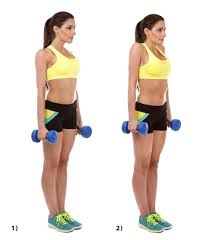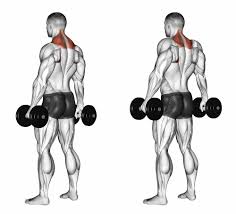

Forward Head Posture (FHP), often called “nerd neck,” is a common postural issue where the head juts forward, leading to a variety of problems like neck pain, headaches, and even breathing difficulties.
Many people believe that fixing this issue requires complex exercises or equipment, but what if I told you that something as simple as shoulder shrugs could help?
Yes, you heard that right!
Let’s dive into how you can use shrugs to fix forward head position and regain that confident, aligned posture.
Article Index
- Understanding Forward Head Posture (FHP)
- Why Shrugs? The Science Behind It
- How to Perform Shrugs to Fix Head Posture?
- What to Avoid?
- Additional Exercises for Forward Head Posture
- Tips for Correct Neck Posture and Everyday Habits
- Conclusion: Can Shrugs Really Fix FHP?
Understanding Forward Head Posture (FHP)
Forward Head Posture is characterized by the head positioning forward of the shoulders, putting excessive strain on the neck and upper back muscles.
This can be caused by prolonged use of electronic devices, poor ergonomic setups, or simply bad posture habits.
If left unchecked, FHP can lead to issues like shoulder forward posture, chronic pain, and even reduced lung capacity.
Why Shrugs? The Science Behind It
You might wonder how something as basic as shrugs could help fix forward head position.
Shrugs target the trapezius muscles, which play a crucial role in stabilizing the neck and shoulders.
By strengthening these muscles, shrugs can pull the shoulders back and support the head in a more neutral position, effectively helping to fix head posture.
A study published in the Journal of Physical Therapy Science found that exercises targeting the trapezius muscles, including shrugs, significantly improved neck posture and reduced symptoms in individuals with FHP.
When done correctly, shrugs can not only improve neck alignment but also alleviate the discomfort associated with poor posture.
How to Perform Shrugs to Fix Head Posture?
Performing shrugs with proper form is key to reaping the benefits.
Here is a step-by-step guide to doing them effectively:
Stand or Sit with Good Posture: Start by standing or sitting upright, ensuring your back is straight and your core is engaged. This is the foundation for any exercise to improve neck posture.
Lift Your Shoulders: Raise your shoulders straight up towards your ears as if you’re trying to touch them. Avoid rolling your shoulders forward or backward—keep the movement vertical.
Hold and Squeeze: At the top of the movement, hold for a couple of seconds and squeeze your shoulder blades together. This engages the upper trapezius muscles, which are crucial for fixing nerd neck.
Lower Slowly: Lower your shoulders back down in a controlled manner. Repeat this movement for 10-15 repetitions.
Add Weight (Optional): Once you’re comfortable with the basic shrug, you can add dumbbells to increase resistance, which can further help in correcting neck posture.
Incorporating shrugs into your regular routine, along with other exercises, can significantly contribute to better neck alignment and reduced FHP.
What to Avoid While Doing Shrugs to Fix Neck Posture
Performing shoulder shrugs can be an effective way to strengthen the trapezius muscles and improve neck posture. However, to maximize benefits and prevent injury, it’s essential to avoid common mistakes. Here’s what to watch out for:
Using Excessive Weight – Lifting too heavy can compromise form, leading to strain on the neck and shoulders. Start with a manageable weight and gradually increase as your strength improves. Proper form is more important than heavy lifting, according to Brain Gain Fitness.
Incorrect Head and Neck Positioning – Tilting your head forward or backward during shrugs can cause alignment issues and discomfort. Keeping your head and neck in a neutral position, looking straight ahead throughout the movement, is recommended by MyProtein.
Rolling Shoulders – Rotating or rolling your shoulders while shrugging adds unnecessary stress to the shoulder joints and does not effectively target the trapezius muscles. WebMD advises lifting your shoulders straight up and down instead of rolling them forward or backward.
Bending Elbows – Allowing your elbows to bend shifts the focus away from the trapezius muscles and can lead to improper form. Keeping your arms straight ensures the shoulders do the work, as emphasized by WebMD.
Neglecting Core Engagement – A weak or unengaged core can lead to poor posture and potential back strain during shrugs. Engaging the abdominal muscles helps maintain stability and proper alignment.
Using Momentum – Jerking or using momentum to lift the weights reduces the effectiveness of the exercise and increases injury risk. Brain Gain Fitness recommends slow, controlled movements to fully engage the target muscles.
Skipping Warm-Up – Jumping straight into shrugs without warming up can lead to muscle strain. The Times highlights the importance of incorporating dynamic stretches and light cardio before resistance exercises.
Poor Posture – Allowing the shoulders to round forward diminishes the effectiveness of shrugs and can worsen poor posture. MyProtein advises keeping the chest lifted and shoulders back to ensure proper form.
Overtraining – Performing shrugs too frequently without adequate rest can lead to overuse injuries. Recovery time is crucial for muscle repair and strength development.
By being mindful of these common pitfalls, shoulder shrugs can be performed safely and effectively, contributing to better neck posture and overall upper body strength.
Additional Exercises for Forward Head Posture
While shrugs are effective, combining them with other exercises for forward head posture can provide even better results.
Here are some complementary exercises:
Chin Tucks: This is a simple yet effective exercise to strengthen the deep cervical flexors, which support the head in an upright position. To perform chin tucks, gently retract your chin towards your neck, hold for 5 seconds, and release. Repeat 10 times.
Wall Angels: Stand with your back against a wall, arms at a 90-degree angle, and slowly raise and lower your arms. This exercise opens up the chest and helps combat shoulder forward posture.
Thoracic Extensions: Sit on a chair and place your hands behind your head. Lean back over the chair’s top, extending your thoracic spine. This movement helps to reverse the slouched posture often seen in FHP.
Combining these exercises with shrugs can provide a well-rounded routine to effectively fix head posture.
Tips for Correct Neck Posture and Everyday Habits
Beyond exercises, making small adjustments in your daily habits can further support correct neck posture:
Adjust Your Workstation: Ensure your computer screen is at eye level, and your chair supports your lower back. This reduces strain on your neck and helps maintain a neutral head position.
Avoid Prolonged Screen Time: Take regular breaks to stretch and move around. This prevents the muscles from becoming stiff and promotes better posture.
Sleep Position: Sleeping on your back with a supportive pillow can help keep your neck in a neutral position, aiding in the fixing of neck posture.
Mindfulness: Be aware of your posture throughout the day. Periodically check if your head is aligned over your shoulders and adjust as needed.
Conclusion: Can Shrugs Really Fix FHP?
So, can shrugs really fix forward head position?
The answer is a resounding yes—when combined with a comprehensive routine of exercises and posture-friendly habits.
Shrugs specifically target the trapezius muscles, which are essential for maintaining proper neck alignment.
By strengthening these muscles, you can support the head in a more neutral position, reducing the strain associated with FHP.
While shrugs alone may not completely fix head posture, they are a valuable addition to a broader exercise regimen designed to combat FHP.
So, the next time you find yourself hunched over your phone or laptop and wonder how to fix fhp, just remember that a few simple shrugs could be your first step toward a healthier neck and a more confident posture.
References:


